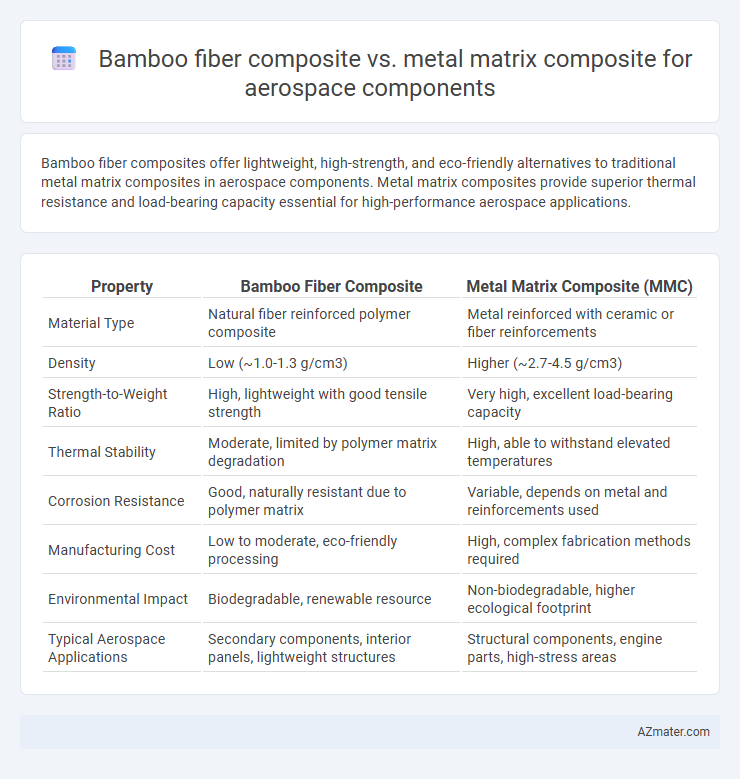Bamboo fiber composites offer lightweight, high-strength, and eco-friendly alternatives to traditional metal matrix composites in aerospace components. Metal matrix composites provide superior thermal resistance and load-bearing capacity essential for high-performance aerospace applications.
Table of Comparison
| Property | Bamboo Fiber Composite | Metal Matrix Composite (MMC) |
|---|---|---|
| Material Type | Natural fiber reinforced polymer composite | Metal reinforced with ceramic or fiber reinforcements |
| Density | Low (~1.0-1.3 g/cm3) | Higher (~2.7-4.5 g/cm3) |
| Strength-to-Weight Ratio | High, lightweight with good tensile strength | Very high, excellent load-bearing capacity |
| Thermal Stability | Moderate, limited by polymer matrix degradation | High, able to withstand elevated temperatures |
| Corrosion Resistance | Good, naturally resistant due to polymer matrix | Variable, depends on metal and reinforcements used |
| Manufacturing Cost | Low to moderate, eco-friendly processing | High, complex fabrication methods required |
| Environmental Impact | Biodegradable, renewable resource | Non-biodegradable, higher ecological footprint |
| Typical Aerospace Applications | Secondary components, interior panels, lightweight structures | Structural components, engine parts, high-stress areas |
Introduction to Aerospace Composites
Aerospace composites are engineered materials combining fibers and matrices designed to achieve high strength-to-weight ratios and enhanced durability. Bamboo fiber composites offer sustainable, lightweight properties with good impact resistance, while metal matrix composites provide superior stiffness, thermal stability, and wear resistance critical for high-performance aerospace components. The selection between bamboo fiber and metal matrix composites depends on specific application demands such as mechanical load, operating temperature, and environmental exposure within aerospace structures.
Overview of Bamboo Fiber Composites
Bamboo fiber composites are gaining attention in aerospace components due to their high strength-to-weight ratio, excellent biodegradability, and sustainable sourcing. These composites exhibit superior mechanical properties such as tensile strength and impact resistance, making them a viable eco-friendly alternative to traditional materials. The natural fibers in bamboo enhance vibration damping and reduce overall component weight, contributing to improved fuel efficiency and reduced environmental impact in aerospace applications.
Features of Metal Matrix Composites
Metal Matrix Composites (MMCs) in aerospace components offer superior strength-to-weight ratios, high thermal conductivity, and excellent wear resistance compared to Bamboo fiber composites. MMCs provide enhanced mechanical properties such as improved stiffness, fatigue resistance, and dimensional stability at elevated temperatures, essential for aerospace environments. Their ability to withstand extreme thermal and mechanical stresses makes them ideal for structural components and engine parts in advanced aerospace applications.
Mechanical Properties Comparison
Bamboo fiber composites exhibit high tensile strength-to-weight ratios and excellent impact resistance, making them suitable for lightweight aerospace components requiring energy absorption. Metal matrix composites (MMCs) provide superior stiffness, thermal stability, and wear resistance under extreme aerodynamic conditions, essential for structural aerospace parts. Comparative analysis indicates that while bamboo fiber composites enhance weight efficiency and vibration damping, MMCs outperform in load-bearing capacity and high-temperature endurance.
Weight and Density Considerations
Bamboo fiber composites exhibit significantly lower density, typically around 1.2 g/cm3, compared to metal matrix composites (MMCs) which range from 2.5 to 3.5 g/cm3 depending on the metal used, offering substantial weight savings crucial for aerospace applications. The reduced weight of bamboo fiber composites enhances fuel efficiency and payload capacity while maintaining adequate mechanical properties through optimized fiber-matrix bonding. Despite MMCs providing superior strength and thermal stability, their higher density often results in increased structural mass, making bamboo fiber composites a promising alternative for lightweight aerospace components where weight reduction is prioritized.
Sustainability and Environmental Impact
Bamboo fiber composite offers significant sustainability advantages over metal matrix composites in aerospace applications due to its renewable nature and lower carbon footprint during production. Bamboo composites exhibit biodegradability and reduced energy consumption, contrasting with metal matrix composites that require high energy-intensive mining and processing of metals like aluminum and titanium. The utilization of bamboo fiber composites supports circular economy principles by minimizing aerospace industry environmental impact through enhanced recyclability and reduced greenhouse gas emissions.
Thermal and Chemical Resistance
Bamboo fiber composites exhibit moderate thermal resistance, typically withstanding temperatures up to 150degC, while metal matrix composites (MMCs) endure significantly higher temperatures often exceeding 600degC, making MMCs more suitable for high-temperature aerospace components. Chemically, bamboo fiber composites are vulnerable to moisture absorption and degradation from UV exposure, whereas MMCs demonstrate superior chemical resistance to corrosion, oxidation, and various aerospace-grade solvents. The superior thermal stability and chemical inertness of metal matrix composites position them as the preferred choice for critical aerospace applications demanding durability under extreme environmental conditions.
Cost Analysis and Availability
Bamboo fiber composites offer a cost-effective alternative to metal matrix composites (MMCs) due to lower raw material and processing expenses, making them attractive for budget-sensitive aerospace components. The availability of bamboo fiber is higher and more sustainable compared to the complex extraction and limited supply of metal matrix materials like aluminum or titanium alloys. While MMCs provide superior strength-to-weight ratios, their elevated cost and limited accessibility often restrict their use to high-performance aerospace parts where expense is justified.
Manufacturing and Processing Techniques
Bamboo fiber composites are manufactured using processes like hand lay-up, vacuum infusion, and compression molding, which are cost-effective and environmentally friendly, allowing for lightweight and flexible aerospace components. Metal matrix composites require advanced techniques such as powder metallurgy, stir casting, and squeeze casting to achieve high strength-to-weight ratios and thermal resistance essential for aerospace applications. The processing of bamboo fiber composites typically involves lower temperatures and less energy compared to the high-temperature sintering and extrusion needed for metal matrix composites, impacting overall production efficiency and component durability.
Suitability for Aerospace Applications
Bamboo fiber composites exhibit lightweight properties and high specific strength, making them suitable for non-structural aerospace components requiring vibration damping and environmental sustainability. Metal matrix composites (MMCs) offer superior mechanical strength, high thermal conductivity, and excellent wear resistance, ideal for structural aerospace parts subjected to high stresses and temperatures. The choice between bamboo fiber composites and MMCs depends on application-critical factors such as load-bearing capacity, weight constraints, and environmental resistance within aerospace engineering.

Infographic: Bamboo fiber composite vs Metal matrix composite for Aerospace component
 azmater.com
azmater.com